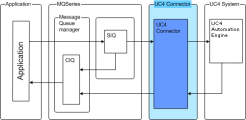Automation Engine Connector for WebSphere MQ Queue Manager
The AE Connector is the link between WebSphere MQ Queue Manager and the Automation Engine.
The AE Connector reads a request, a message in XML format, from the request queue (SIQ) and forwards it for processing to the Automation Engine. An internal format is used for this. The AE Connector waits for the Automation Engine to verify processing and notify the end of the process. Here an internal format is also used. The answer is assigned to the request from the AE Connector and written in XML format into the reply queue (CIQ).
Note: This integration capability, like all integrations of the Automic system, can support service orchestration workflows. Such workflows orchestrate automated processes that run across multiple platforms, domains, and applications to deliver a specific IT service. For more information, see About Service Orchestration.
This page includes the following:
XML Request Message
| XML element | Description |
|---|---|
| <apiscriptexec> | Start of API request
XML element must be present |
|
<uc-env request="ID" release="1"> |
The ID identifies the request
The request= attribute must be entered. The AE Connector refers to this ID in its messages. This ID is also written in the reply message The release= attribute is not required. If it is still entered, at the moment only the value 1 is allowed. On the future this attribute will serve as the version entry XML element must be present |
|
<requestname name="any name"> |
Name of the request Attribute name= is not required XML element must be present |
|
<control> |
XML element must be present |
|
<timeout unit="sec">10</timeout> |
Request runtime limit
Runtime starts before establishing connection with the Automation Engine and ends when AE accepts execution or an unrecoverable error occurs. The unit= attribute is used to define the runtime unit Allowed values: 1 - 31999 XML element is not necessary |
|
<control unit="sec">20</control> |
Not yet supported by current version.
XML element is not necessary |
|
</control> |
Element termination <control>
XML element is not necessary |
|
<login> |
Start of element for login information
XML element must be present |
|
<system>Automation Engine name</system> |
Name of Automation Engine The name is used for checking the connection to the Automation Engine. The contents correspond to the name= parameter in the INI file of the Automation Engine to which the AE Connector has established a connection. For more information, see Automation Engine. XML element must be present. |
|
<client>client number</client> |
Client number for logging on to the Automation Engine XML element must be present |
|
<name>user name</name> |
User name for logging on to the Automation Engine XML element must be present |
|
<department>user's department</department> |
Designation of user's department for logging on to the Automation Engine XML element must be present |
|
<passw>password</passw> |
User password for logging on to the Automation Engine XML element is not necessary |
|
<language>E/D/F</language> |
Choice of language in which messages are to be output
If no language is specified, massages are written according to the setting in the INI file of the AE Connector XML element is not necessary |
|
<clienttype>C</clienttype> |
Clients type
If the type is to be specified, currently only C is allowed XML element is not necessary |
|
<clientvers>client version</clientvers |
Version of AE Connector
Allowed values: Current Version XML element is not necessary |
|
</login> |
Termination for XML element <login>
XML element must be present |
|
<script><![CDATA[Script content]]></script> |
Script statements to be executed in AE XML element must be present |
|
</request> |
Termination for XML element <request>
XML element must be present |
|
</uc-env> |
Termination for XML element <uc-env>
XML element must be present |
| </apiscriptexec> | Termination for XML element <apiscriptexec>
XML element must be present |
Example
<apiscriptexec>
<uc-env request="ID1" release="1">
<request name="apiscriptexec">
<control>
<timeout unit="sec">10</timeout>
</control>
<login>
<system>UC4</system>
<client>97</client>
<name>NAME01</name>
<department>DEPARTMENT01</department>
<passw></passw>
<language>D</language>
<clienttype>C</clienttype>
<clientvers>11.0.0</clientvers>
</login>
<script><![CDATA[:SET &RUNNR = ACTIVATE_UC_OBJECT(JOBS,EXAMPLE1)]]></script>
</request>
</uc-env>
</apiscriptexec>
XML Reply Message
| XML Element | Description |
|---|---|
| <apiscriptexec> | Outer message frame
XML element is always present |
|
<uc-env request="ID" release="1"> |
The provided ID is removed from its corresponding request. The request= attribute is always output XML element is always present |
|
<result name="Reply"> |
XML element is always present |
|
<status>reason</status> |
Reason for this reply to a request Currently the reply is always completed XML element is always present |
|
<complcode>code</complcode> |
Completion code supplied by the AE Connector for the executed
request. All possible codes are described in the message manual XML element is always present |
|
<compltext>![CDATA[completion text]]</compltext> |
Description text for completion code
XML element is always present |
|
<returnvalue>value</returnvalue> |
Return value from components which were present during processing
( Automation Engine, XML Parser, and so on)
XML element is always present |
|
<returntext>![CDATA[return text]]</returntext> |
Description of return value
XML element is always present |
|
</result> |
Termination for XML element <result>
XML element is always present |
|
</uc-env> |
Termination for XML element <uc-env>
XML element is always present |
| </apiscriptexec> | Termination for XML element <apiscriptexec>
XML element is always present |
